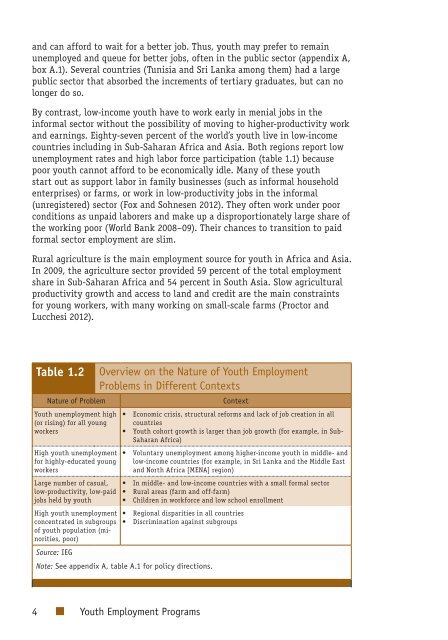Youth Employment Programs - Independent Evaluation Group
Youth Employment Programs - Independent Evaluation Group
Youth Employment Programs - Independent Evaluation Group
You also want an ePaper? Increase the reach of your titles
YUMPU automatically turns print PDFs into web optimized ePapers that Google loves.
and can afford to wait for a better job. Thus, youth may prefer to remainunemployed and queue for better jobs, often in the public sector (appendix A,box A.1). Several countries (Tunisia and Sri Lanka among them) had a largepublic sector that absorbed the increments of tertiary graduates, but can nolonger do so.By contrast, low-income youth have to work early in menial jobs in theinformal sector without the possibility of moving to higher-productivity workand earnings. Eighty-seven percent of the world’s youth live in low-incomecountries including in Sub-Saharan Africa and Asia. Both regions report lowunemployment rates and high labor force participation (table 1.1) becausepoor youth cannot afford to be economically idle. Many of these youthstart out as support labor in family businesses (such as informal householdenterprises) or farms, or work in low-productivity jobs in the informal(unregistered) sector (Fox and Sohnesen 2012). They often work under poorconditions as unpaid laborers and make up a disproportionately large share ofthe working poor (World Bank 2008–09). Their chances to transition to paidformal sector employment are slim.Rural agriculture is the main employment source for youth in Africa and Asia.In 2009, the agriculture sector provided 59 percent of the total employmentshare in Sub-Saharan Africa and 54 percent in South Asia. Slow agriculturalproductivity growth and access to land and credit are the main constraintsfor young workers, with many working on small-scale farms (Proctor andLucchesi 2012).Table 1.2Nature of Problem<strong>Youth</strong> unemployment high(or rising) for all youngworkersHigh youth unemploymentfor highly-educated youngworkersLarge number of casual,low-productivity, low-paidjobs held by youthHigh youth unemploymentconcentrated in subgroupsof youth population (minorities,poor)Overview on the Nature of <strong>Youth</strong> <strong>Employment</strong>Problems in Different ContextsContext• Economic crisis, structural reforms and lack of job creation in allcountries• <strong>Youth</strong> cohort growth is larger than job growth (for example, in Sub-Saharan Africa)• Voluntary unemployment among higher-income youth in middle- andlow-income countries (for example, in Sri Lanka and the Middle Eastand North Africa [MENA] region)• In middle- and low-income countries with a small formal sector• Rural areas (farm and off-farm)• Children in workforce and low school enrollment• Regional disparities in all countries• Discrimination against subgroupsSource: IEGNote: See appendix A, table A.1 for policy directions.4 <strong>Youth</strong> <strong>Employment</strong> <strong>Programs</strong>
















